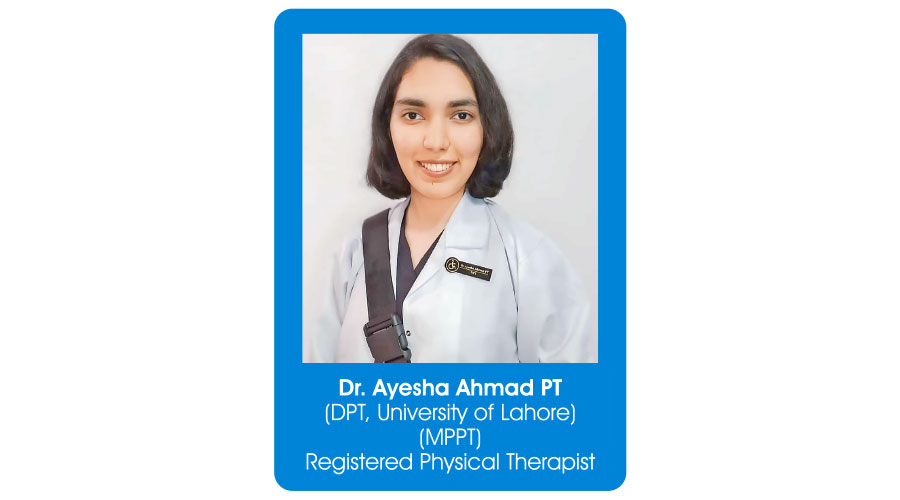ASK A PHYSICAL THERAPIST
- 04 May - 10 May, 2024

Q: I am a 24 years old male and frequently participate in sports. I have pain and inflammation on my heel and have been told that I have bursitis. Kindly guide us about the condition and the physical therapy options available as a treatment.
A: You are probably suffering from retrocalcaneal bursitis. It is the inflammation of the bursa located between the calcaneus and the anterior surface of the Achilles tendon. It is also known as Achilles tendon bursitis. It can often be mistaken for Achilles Tendinopathy or can also occur in conjunction with Achilles tendinopathy. A bursa appears at a junction of a tendon on the bone. A bursa is filled with a thin layer of synovial fluid. It protects and brakes the shocks of the joint. Retrocalcaneal bursitis is common in both the sporting athlete and the general population. In normal populations, its incidence is high in individuals who are accustomed to wearing high-heeled shoes on a long-term basis and may experience increased stretch and irritation of the Achilles tendon and its associated bursae when switching to flat shoes. A retrocalcaneal bursa mat occurs traumatically from a fall or a sport-related impact contusion or it can also present as a gradual onset due to repetitive trauma to the bursa from activities including running or excessive loading, Overtraining in an athlete, Tight or poorly fitting shoes that produce excessive pressure at the posterior heel, Haglund deformity, Altered joint axis. Retrocalcaneal bursitis may also be associated with conditions such as gout, rheumatoid arthritis, and seronegative spondyloarthropathies.
Symptoms include pain at the back of the heel, especially when running uphill, Pain may get worse when rising on the toes (standing on tiptoes), Tenderness at the back of the heel, swelling at the back of the heel, Increase in pain in activities which load the calf. A Physical Therapist works by evaluation of the tendon, bursa, and calcaneum by, careful history, inspection of the region for bony prominence and local swelling as well as palpation of the area of maximal tenderness. Biomechanical abnormalities, joint stiffness, and proximal soft tissue tightening can exacerbate an anatomical predisposition to retrocalcaneal bursitis, they warrant correction when present. X-rays, MRI, etc can be required in some cases.
In the acute phase, ice can be applied to the posterior heel and ankle several times a day. Patients with retrocalcaneal bursitis should be instructed to apply ice to the posterior heel and ankle in the acute period of bursitis. Icing can be performed several times a day, for 15-20 minutes each. Stretching is also added to the plan and appropriate modifications are guided.
Q: My mother is 53 years old and has severe vertigo when she changes her position from lying to sitting. It happens quite a lot and she is exhausted Kindly guide her if a physical therapist can help in this case and why does this happen.
A: The true diagnosis requires a thorough examination by both ENT and orthopedic specialists to confirm the structure that is involved and the reason behind vertigo. Sometimes a Neuro specialist may also check the patient if required. Generally, the case falls in Benign paroxysmal positional vertigo (BPPV) is a specific type of vertigo that is brought on by a change in the position of the head concerning gravity. This disorder is caused by problems in the inner ear. Its symptoms are repeated episodes of positional vertigo, that is, a spinning sensation caused by changes in the position of the head.
BPPV is thought to arise due to the displacement of otoconia (small crystals of calcium carbonate) from the maculae of the inner ear into the fluid-filled semicircular canals. These semicircular canals are sensitive to gravity and changes in head position can be a trigger for BPPV
Symptoms include vertigo, which is a pinning sensation (not lightheadedness or feeling off-balance.). The short duration may last only seconds to minutes (usually less than 60 seconds. Positional onset is only induced by a change in position, there can be nausea. There may be Visual disturbance and it may be difficult to read or see during an attack, pre-Syncope (feeling faint), or Syncope (fainting), vomiting is uncommon, but possible. Loss of balance Symptoms are considered mild if there is inconsistent positional vertigo, moderate if there are frequent positional vertigo attacks with disequilibrium between vertigo attacks, and severe: vertigo with most head movements, which can appear as continuous vertigo. Individuals with BPPV can have symptoms that last days, weeks, months, or years before it is resolved
It can be triggered by any action which stimulates the posterior semi-circular canal which may be tilting the head, rolling over in bed, looking up or under, or sudden head motion. BPPV may be made worse by any number of modifiers which may vary between individuals, changes in barometric pressure - patients often feel symptoms approximately two days before rain or snow, lack of sleep (required amount of sleep may vary widely), stress.
The most common cause of BPPV is idiopathy. However, the vestibular system of the inner ear can also undergo degenerative changes as one age which can attribute to a potential cause of BPPV. Under the age of 50, head injury is a common cause. Vestibular viruses and Meniere’s disease also play a role. BPPV can also be a result of surgery due to prolonged supine positioning and possible trauma to the inner ear. Risk factors include Female gender, Hypertension (HTN), Hyperlipidemia, Cerebrovascular disease, Menopause, Allergies, Migraine, Chronic Obstructive Pulmonary Disease (COPD), Surgical procedures such as a cochlear implant, and Infection.
A physical therapist carefully assesses the patient and applies special tests for confirmation of the diagnosis. He also includes specialized maneuvers for the problem. There is a vestibular rehabilitation plan that is designed for the patient with exercises. These exercises improved nystagmus, postural control, movement-provoked dizziness, the ability to perform activities of daily living independently, and levels of distress.
COMMENTS